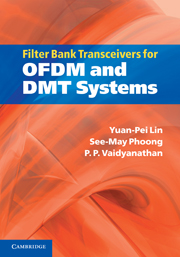Book contents
- Frontmatter
- Dedication
- Contents
- Preface
- 1 Introduction
- 2 Preliminaries of digital communications
- 3 FIR equalizers
- 4 Fundamentals of multirate signal processing
- 5 Multirate formulation of communication systems
- 6 DFT-based transceivers
- 7 Precoded OFDM systems
- 8 Transceiver design with channel information at the transmitter
- 9 DMT systems with improved frequency characteristics
- 10 Minimum redundancy FIR transceivers
- A Mathematical tools
- B Review of random processes
- References
- Index
6 - DFT-based transceivers
Published online by Cambridge University Press: 05 August 2015
- Frontmatter
- Dedication
- Contents
- Preface
- 1 Introduction
- 2 Preliminaries of digital communications
- 3 FIR equalizers
- 4 Fundamentals of multirate signal processing
- 5 Multirate formulation of communication systems
- 6 DFT-based transceivers
- 7 Precoded OFDM systems
- 8 Transceiver design with channel information at the transmitter
- 9 DMT systems with improved frequency characteristics
- 10 Minimum redundancy FIR transceivers
- A Mathematical tools
- B Review of random processes
- References
- Index
Summary
The most commonly used type of block transceiver is the so-called DFT-based transceiver, in which the polyphase matrices of the transnritter and receiver are related to low-cost DFT matrices in a simple way. The DFT-based transceiver has found applications in a wide range of transmission channels. wired [12, 154] or wireless [27]. It is typically called a DMT (discrete multitone) system for wired DSL (digital subscriber line) applications [7, 8] and an OFDM (orthogonal frequency division multiplexing) system for wireless local area networks [54] and broadcasting applications, e.g. digital audio broadcasting [39] and digital video broadcasting [40]. In an OFDM or DMT transceiver, the transmitter and receiver perform, respectively, IDFT and DFT computations. Another type of DFT-based transceiver, called a singlecarrier system with cyclic prefix (SC-CP), has also been of great importance in wireless transmission [55, 128, 130]. The SC-CP system transmits a block of synrbols directly after inserting a cyclic prefix while the receiver performs both DFT and IDFT computations.
For wireless transmission, the channel state information is usually not available to the transmitter. The transmitter is typically channel-independent and there is no bit or power allocation. Having a channel-independent transmitter is also a very useful feature for broadcasting applications, where there are many receivers with different transmission paths. In OFDM or SC-CP systems for wireless applications, there is usually no bit and power allocation. The transmitters have the desirable channel-independence property. The channel-dependent part of the transceiver is a set of M scalars at the receiver, where M is the number of subchannels. In DMT systems for wired DSL applications, signals are transmitted over copper lines. The channel does not vary rapidly. This allows tinre for the receiver to send back to the transmitter the channel state information, based on which bit and power allocation can be optimized. Using bit allocation, the disparity among the subchannel noise variances is exploited in the DMT system for bit rate maximization. The DMT system has been shown to be very efficient for high-speed transmission.
- Type
- Chapter
- Information
- Filter Bank Transceivers for OFDM and DMT Systems , pp. 135 - 192Publisher: Cambridge University PressPrint publication year: 2010



